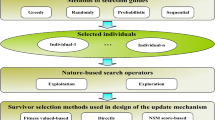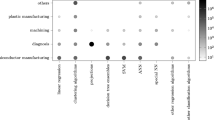Abstract
This multidisciplinary research presents a novel hybrid intelligent system to perform a multi-objective industrial parameter optimization process. The intelligent system is based on the application of evolutionary and neural computation in conjunction with identification systems, which makes it possible to optimize the implementation conditions in the manufacturing process of high precision parts, including finishing precision, while saving time, financial costs and/or energy. Empirical verification of the proposed hybrid intelligent system is performed in a real industrial domain, where a case study is defined and analyzed. The experiments are carried out based on real dental milling processes using a high precision machining centre with five axes, requiring high finishing precision of measures in micrometers with a large number of process factors to analyze. The results of the experiments which validate the performance of the proposed approach are presented in this study.







Similar content being viewed by others
References
Corchado E, Sedano J, Curiel L, Villar JR (2012) Optimizing the operating conditions in a high precision industrial process using soft computing techniques. Expert Systems 29(3):276–299. http://dx.doi.org/10.1111/j.1468-0394.2011.00588.x
Frank M, Hamprecht F (2011) Image-based supervision of a periodically working machine. Pattern Anal Appl 1–10. http://dx.doi.org/10.1007/s10044-011-0245-7
Huang L, Suh IH, Abraham A (2011) Dynamic multi-objective optimization based on membrane computing for control of time-varying unstable plants. Inf Sci 181(11):2370–2391
Das MK, Kishor N (2009) Adaptive fuzzy model identification to predict the heat transfer coefficient in pool boiling of distilled water. Expert Syst with Appl 36(2, Part 1):1142–1154
Esen H, Inalli M (2009) Modelling of a vertical ground heat pump system by using artificial neural networks. Expert Syst Appl 36(7):10229–10238
Ljung L (1999) System identification, theory for the user, 2nd edn. Prentice-Hall, Upper Saddle River
Sedano J, Corchado E, Curiel L, Villar J, Bravo PM (2009) The application of a two-step AI model to an automated pneumatic drilling process. Int J Comput Math 86(10):1769–1777
Sedano J, Curiel L, Corchado E, de la Cal E, Villar JR (2010) A soft computing based method for detecting lifetime building thermal insulation failures. Integr Comput-Aided Eng 17(2):103–115
Vera V, Corchado E, Redondo R, Sedano J, García ÁE (2013) Applying soft computing techniques to optimise a dental milling process. Neurocomputing 109:94–104. http://dx.doi.org/10.1016/j.neucom.2012.04.033
Kalyani S, Swarup K (2012) Design of pattern recognition system for static security assessment and classification. Pattern Anal Appl 15 (3):299–311. http://dx.doi.org/10.1007/s10044-011-0218-x
Miyazaki T, Hotta Y, Kunii J (2009) A review of dental CAD/CAM: current status and future perspectives from 20 years of experience. Dent Mater J 28(1):44–56
Fuster-Torres MA, Albalat-Estela S, Alcañiz-Raya M, Peñarrocha-Diago M (2009) CAD/CAM dental systems in implant dentistry: Update. Med Oral Patol Oral Cir Bucal 14(3):E141–E145
Beuer F, Schweiger J, Edelhoff D (2008) Digital dentistry: an overview of recent developments for CAD/CAM generated restorations. Br Dent J 204(9):497–502
Weaver J, Johnson G, Bales D (1991) Marginal adaptation of castable ceramic crowns. J Prosthet Dent 66:747–753
(2005) Glossary of Prosthodontic Terms. J Prosthet Dent 94: 92
Wolfart S, Martin S, Kern M (2003) Clinical evaluation of marginal fit of a new experimental all—ceramic system before and after cementation. Int J Prosthodont 6:587–592
Francine E, Omar M (2004) Marginal adaptation and microleakage of Procera All Ceram crowns with four cements. Int J Prosthodont 17:529–535
McLean J, von Fraunhofer JA (1971) The estimation of cement film by an in vivo technique. Br Dent J 131:107–111
Karlsson S (1993) The fit of Procera titanium crowns. An in vitro and clinical study. Acta Odontol Scand 51:129–134
Vera V, Sedano J, Corchado E, Redondo R, Hernando B, Camara M, Laham A, Garcia AE (2011) A hybrid system for dental milling parameters optimisation. In: 6th International conference on hybrid artificial intelligence systems. Wroclaw, Poland HAIS 2011, Part II, LNAI 6679, pp 437–446
Corchado E, Graña M, Wozniak M (2012) Editorial: new trends and applications on hybrid artificial intelligence systems. Neurocomputing 75(1):61–63
Chang Hsu-Hwa, Chen Yan-Kwang (2011) Neuro-genetic approach to optimize parameter design of dynamic multiresponse experiments. Appl Soft Comput 11(1):436–442
Corchado E, Abraham A, Ponce Leon Ferreira de Carvalho AC (2010) Hybrid intelligent algorithms and applications. Inf Sci 180(14):2633–2634
Abraham A, Corchado E, Corchado JM (2009) Hybrid learning machines. Neurocomputing 72(13–15):2729–2730
Borrajo ML, Baruque B, Corchado E, Bajo J, Corchado JM (2011) Hybrid neural intelligent system to predict business failure in small-to-medium-size enterprises. Int J Neural Syst 21(4):277–296
Fujita S (2009) Retrieval parameter optimization using genetic algorithms. Inf Process Manage 45:664–682
Oliveira ALI, Braga PL, Lima RMF, Cornélio ML (2010) Ga-based method for feature selection and parameters optimization for machine learning regression applied to software effort estimation. Inf Softw Technol 52:1155–1166
Dorigo M, Stützle T (2004) Ant Colony Optimization. Bradford Co, Scituate
Liu Y, Zhou C, Guo D, Wang K, Pang W, Zhai Y (2010) A decision support system using soft computing for modern international container transportation services. Appl Soft Comput 10(4):1087–1095
Twycross J, Aickelin U (2010) Information fusion in the immune system. Inf Fusion 11(1):35–44
Corchado E, Herrero A (2011) Neural visualization of network traffic data for intrusion detection. Appl Soft Comput 11(2):2042–2056
Fougères A (2011) Modelling and simulation of complex systems: an approach based on multi-level agents. IJCSI Int J Comput Sci Issues 8(6):8–17
Castro JL, Navarro M, Sánchez JM, Zurita JM (2009) Loss and gain functions for CBR retrieval. Inf Sci 179(11):1738–1750
Pearson K (1901) On lines and planes of closest fit to systems of points in space. Phil Mag 2(6):559–572
Hotelling H (1933) Analysis of a complex of statistical variables into Principal Components. J Educ Psychol 24:417–444
Oja E, Ogawa H, Wangviwattana J (1992) Principal components analysis by homogeneous neural networks, part 1, the weighted subspace criterion. IEICE Trans Inf Syst E75D:366–375
Diaconis P, Freedman D (1984) Asymptotics of graphical projections. Ann Stat 12(3):793–815
Corchado E, MacDonald D, Fyfe C (2004) Maximum and minimum likelihood hebbian learning for exploratory projection pursuit. Data Min Knowl Disc 8(3):203–225
Friedman JH (1987) Exploratory projection pursuit. J Am Stat Assoc 82(397):249–266
Pedrycz W, Lee D, Pizzi N (2010) Representation and classification of high-dimensional biomedical spectral data. Pattern Anal Appl 13(4):423–436
Gunala S, Edizkanb R (2008) Subspace based feature selection for pattern recognition. Inf Sci 178(19):3716–3726
Corchado E, Fyfe C (2003) Connectionist techniques for the identification and suppression of interfering underlying factors. Int J Pattern Recognit Artif Intell 17(8):1447–1466
Fyfe C, Corchado E (2002) Maximum likelihood hebbian rules. In: Verleysen M (ed) Proceedings of the 10th Eurorean Symposium on Artificial Neural Networks, Bruges, Belgium, April 24-26 (ESANN 2002), pp 143–148
Corchado E, Han Y, Fyfe C (2003) Structuring global responses of local filters using lateral connections. J Exp Theor Artif Intell 15(4):473–487
Seung H, Socci N, Lee D (1998) The rectified Gaussian distribution. Adv Neural Inf Process Syst 10:350–356
Nørgaard M, Ravn O, Poulsen NK, Hanse LK (2000) Neural networks for modelling and control of dynamic systems. Springer-Verlag, London
Schoukens J, Rolain Y, Pintelan R (2004) Improved approximate identification of nonlinear systems. In: 21st IEEE instrumentation and measurement technology conference, Como, Italy, pp 2183–2186
Hanne T (2000) Global multi-objective optimization using evolutionary algorithms. J Heuristics 6(3):347–360
Srinivas N, Deb K (1995) Multi-objective function optimization using nondominated sorting genetic algorithms. Evol Comput J 2(3):221–248
Deb K, Pratap A, Agarwal S, Meyarivan T (2000) A fast elitist multi-objective genetic algorithm: NSGA-II. IEEE Trans Evol Comput 6:182–197
Luciano Sánchez L, Villar JR (2008) Obtaining transparent models of chaotic systems with multi-objective simulated annealing algorithms. Inf Sci 178:952–970
Demuth H, Beale M, Hagan M (2010) Neural Network Toolbox User’s Guide. The Mathworks Inc., Natick
The Math Works. Global Optimization Toolbox. The MathWorks Inc., URL: http://www.mathworks.com/products/global-optimization/index.html
Fletcher R (1987) Practical methods of optimization, 2nd edn. Wiley & Sons, Chichester
Dennis JE, Schnabel RB (1983) Numerical methods for unconstrained optimization and nonlinear equations. Prentice-Hall, Englewood Cliffs
Riedmiller M, Braun H (1993) A directive adaptive method for faster backpropagation learning: The RPROP algorithm. In: Proceedings for IEEE International Conference on Neural Networks
Moller MF (1993) A scaled conjugate gradient algorithm for fast supervised learning. Neural Netw 6:525–533
Mackay DJC (1992) Bayesian interpolation. Neural Comput 4(3):415–447
Acknowledgments
This research is partially supported through projects of the Spanish Ministry of Economy and Competitiveness [ref: TIN2010-21272-C02-01 (funded by the European Regional Development Fund), TIN2008-06681-C06-04 and SA405A12-2 from Junta de Castilla y León]. The authors would also like to thank to ESTUDIO PREVIO (Madrid-Spain) for its collaboration in this research.
Author information
Authors and Affiliations
Corresponding author
Rights and permissions
About this article
Cite this article
Redondo, R., Sedano, J., Vera, V. et al. A novel hybrid intelligent system for multi-objective machine parameter optimization. Pattern Anal Applic 18, 31–44 (2015). https://doi.org/10.1007/s10044-013-0345-7
Received:
Accepted:
Published:
Issue Date:
DOI: https://doi.org/10.1007/s10044-013-0345-7




